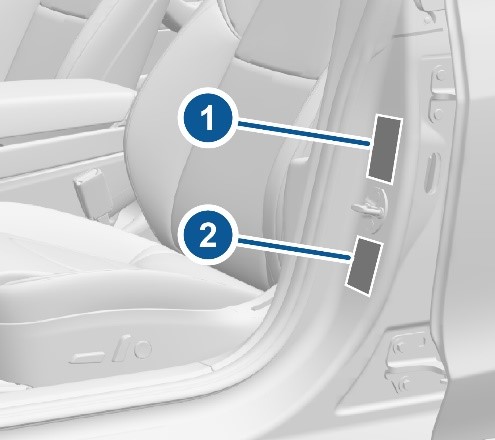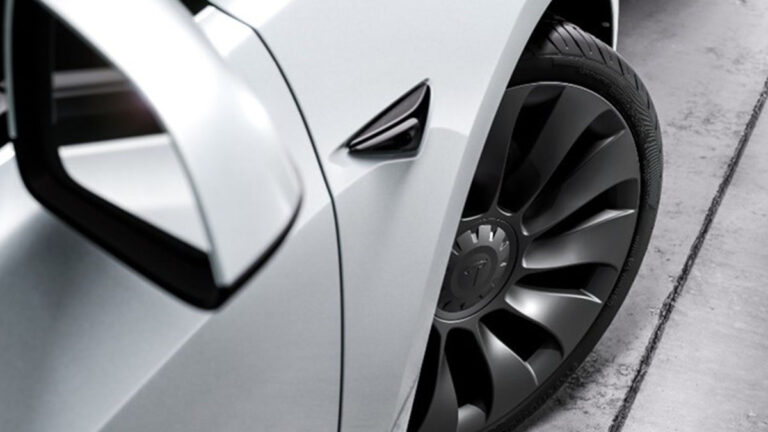Regular tire rotation is crucial in a Tesla to maintain the performance and aid longevity of your tries. This helps in even wear progression on the tires, to maintain predictable handling and lowering the risk of a tire blowout.
Uneven tire wear can pose a considerable risk as it can result in unexpected traction loss that even Tesla’s traction control and stability control systems cannot compensate for.
If you are an enthusiast who owns a high-performance Tesla, like a Model 3 Performance or a Model S Plaid, it becomes even more critical to monitor tire wear meticulously and perform regular tire rotations. So, what is Tesla’s recommended tire rotation pattern?
Tesla’s Recommended Tire Rotation Pattern
Tesla’s guideline is to carry out tire rotations every 6,250 miles (10,000 km) or when there is about 2/32 of an inch (1.5 mm) difference in tread depth between tires, whichever comes first.
Rotate Tires Every 6,250 miles (10,000 km) front-to-rear
Tesla recommends a front-to-rear and rear-to-front rotation pattern without changing sides. This translates to swapping your front left tire with your rear left tire and your front right tire with your rear right tire.

Post tire rotation, it is crucial to navigate to Controls > Service > Wheel & Tire Configuration > Tires and update your vehicle’s tire configuration. This allows your Tesla to know that the tires have been rotated and will remind you for another rotation after 6,250 miles.
Step-by-Step Guide on Rotating Tires on a Tesla
What you’ll need: 2.5 Ton jack, Four jack stands, torque wrench, breaker bar, 21mm socket, long wrench (optional).
- Preparation – Find the lifting points on your Tesla. Insert a certified Tesla jack puck into the corresponding slots positioned under the vehicle. Ensure to perform this procedure on both sides, and always on level ground, ideally in a secured environment like your garage.
- Engage the Parking Brake – Activate the parking brake via Controls > Safety > Parking Brake menu.
- Loosen Lug Nuts – Prior to lifting the car, loosen the lug nuts with a breaker bar.
- Lift the Vehicle, Starting with the Front Axle – Confirm the jack’s correct positioning and gently elevate the car until the wheels are few inches off the ground. Begin by raising the front axle, followed by the rear axle. Use jack stands if possible.
- Tire Rotation Procedure – Replace the left rear tire with the left front tire and similarly replace the right front tire with the right rear tire.
- Hand Tightening of Lug Nuts – Excessive tightening of lug nuts is not needed before lowering your Tesla down to the ground. Apply moderate hand torque with a wrench. Ensure all four wheels are securely attached to the vehicle and all lug nuts are moderately tightened.
- Lower the vehicle, Starting with the Rear Axle – Lower the rear wheels to the ground, and then lower the front ones.
- Torquing the Tires – Set a torque wrench to 130 ft-lbs and apply torque to all lug nuts in a star pattern after lowering the car.
- Retorque After Few Days – It is recommended to retorque your wheels to 130 ft-lbs after covering a few hundred miles to ensure all lug nuts remain torqued adequately.
Additional Tips for Optimal Tire Care
Prioritize Tread Depth for Rear Axle
Tesla recommends that tires with the most tread be placed on the rear axle. Tesla’s send most of the torque to the rear wheels, even in dual motor all-wheel-drive models.
Having high tread on the rear axle will also reduce oversteer, which is more difficult to correct and react to than understeer.
Maintain Optimal Tire Pressure
Keep the tire pressure at the level specified in the owner’s manual or the information label inside the driver’s door. In addition to this, Teslas come with a built-in tire pressure monitoring system (TPMS) that alerts you when tire pressure is low. Aim to check tire pressures at least every month.

It is also a good practice to examine the tires for defects, cuts, scratches, punctures, or any other imperfections that could potentially lead to loss of air pressure.
Regular Tire Rotation
As we already highlighted, tire rotations play a significant role in optimizing the longevity and performance of your tires.
Uneven tread depth can have a detrimental effect on the traction levels of your vehicle. This effect is more pronounced in high power and AWD vehicles, typical of most Teslas.
Monitor Tire Tread Depth
Powerful and heavy cars like the Model S Plaid can quickly wear out a set of tires. The substantial torque output from the electric motors can reduce tire life substantially quicker than expected. That plus the relatively heavy curb weight of Tesla’s isn’t nice on tires/
If the tire tread depth is less than 2/32 of an inch or the wear indicators suggest that the tire is worn out, it is time to replace them.
Avoid Overloading Your Tires
Refrain from overloading the vehicle or exceeding the maximum load capacity as specified in the owner’s manual. Overlooking this can lead to excessive tire wear and can also affect their performance.
Take the maximum load capacity of your Tesla and the tires you are using into account when towing or carrying heavy loads in the trunk.
Proper Storage of Tires
If you have two sets of tires, store the unused set of tires in a cool, dry, and dark location away from direct exposure to sunlight and excessive heat.
Wrapping Up & Our Recommendations
Tesla recommends a standard front-to-back tire rotation pattern without interchanging the tires from left to right or right to left (i.e., avoid X pattern rotations).
In addition to this, Tesla advises to always install your best tires on the rear axle. This holds true even for all-wheel-drive Teslas as the majority of the car’s torque will be applied towards the rear wheels.

